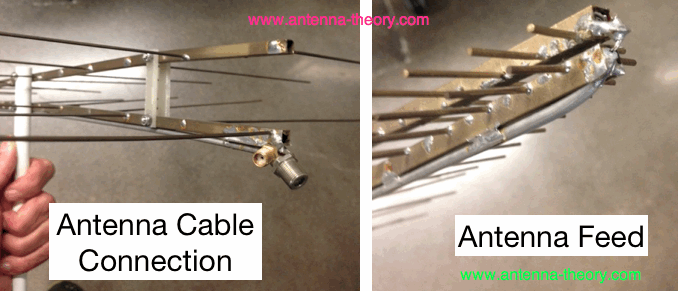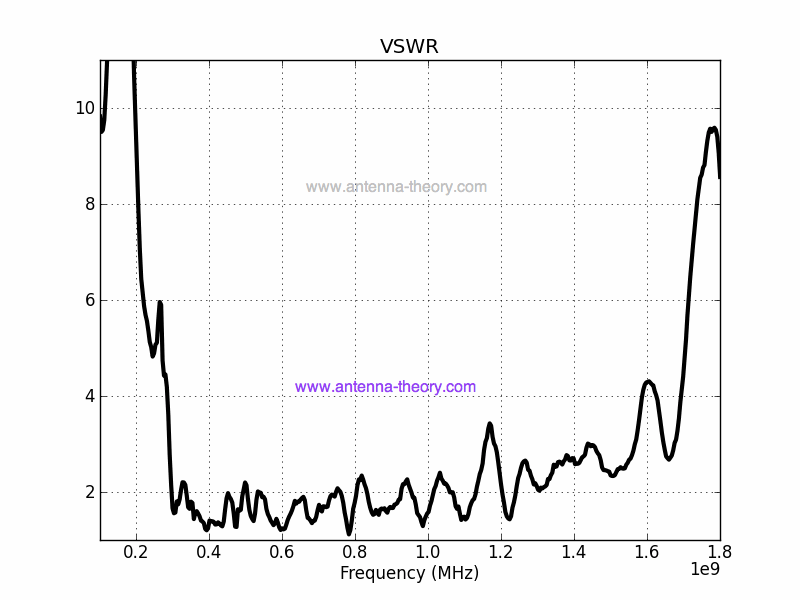Log-Periodic Dipole Array Antenna
|
We discuss the properties of Log Periodic Antennas on the previous Log Periodic Tooth Antenna page. Now we expand on that design further and introduce the Log-Periodic Dipole Antenna Array (sometimes abbreviated LPDA). In Figure 1, we show the basic 5 element Log-Periodic Dipole Antenna Array:
 Figure 1. Log Periodic Dipole Array with 5 Arms. For the array in Figure 1, we use an expansion factor k=1.25. This means that each dipole is 25% longer than the one to the left of it, and the separation (d) between each dipole also increases by 25%. In addition, the log-periodic dipole array is arranged such that each element is fed out of phase to the element on either side. This is illustrated by the criss crossing feed pattern in Figure 1. This antenna is often characterized by "active" and "passive" regions. This means that if we are discussing the radiation mechanism at say f=300 MHz, then the bulk of the radiation from this antenna will come from the dipoles with lengths near half a wavelength at 300 MHz (so L=0.5 meters). This is illustrated in Figure 2.
 Figure 2. Illustration of LPDA Active and Inactive Regions. In Figure 2, we see that the elements near the half-wavelength dipole will contribute to the radiation of the LPDA, however the other elements will not. The elements that are too short will be too capacitive to radiate; the elements much longer than a half-wavelength will also not radiate well. Note that this is somewhat of an approximation, as if elements are 1.5 wavlengths, they will tend to radiate well. However, this should give a bit of intuition. If we assume 3 active elements as in Figure 2, then one could argue that this antenna resembles somewhat a 3-element Yagi-Uda Antenna. That is, the driven arm is in the center, the reflector element is the longer dipole to the right, and the director is the shorter dipole to the left as seen in Figure 2. As such, the direction of peak radiation for the LPDA in Figure 2 is towards the left. Another interpretation of the radiation mechanism of the log periodic dipole array is that if the Log Periodic Tooth Antenna has the arms reduced to wires (dipoles), and it is folded back on itself, then the LP tooth would reduce to the log periodic dipole antenna array. This represents somewhat of an evolution then of the Log Periodic Tooth antenna. The design of the log periodic dipole array antenna as shown in Figure 1 is somewhat of an empirically successful design. That is, there is a bit of intuition we can give regarding this antenna as in the preceeding paragraphs; however, generally this antenna is one that has been found to work well in practice after experimentation. As an example, it is experimentally found that for good antenna gain, the expansion factor (k) should be kept small (1.25 being on the high side). We will go through the design of a real world Log Periodic Dipole Antenna, which was done by a Mr. Enrique Ayala, shown in Figure 3:  Figure 3. Enrique holding his LPDA Antenna. The design is broken down as shown in Figure 4. We will use a total of N=25 elements (dipole antennas), with diameters of 0.077". The expansion factor k is 1.1 as shown:
 Figure 4. Design Parameters for Enrique's LPDA Antenna. Now, let's look at the feed for Enrique's antenna. The coaxial antenna feed cable runs along the length of the lower metallic support boom, and feeds directly across the vertex gap as shown in Figures 4 and 5:  Figure 5. Antenna Feed For LPDA Antenna. On the left in Figure 5, we see two connections to plug in the antenna, a SMA connector and an F-type connector. These both connect to the same antenna feed port, this is just for versatility. The feed cable then run alongs the lower boom of the antenna, and then connects as shown on the right side of Figure 5. The center conductor of the coaxial cable feeds to the upper boom, and the outer conductor of the coaxial feed grounds to the lower boom. In this manner we have implemented the feed across the gap required in Figure 2. In addition, we need to have the oscillating connections between dipoles as shown in Figure 2. This is accomplished in a simple manner. As shown in Figure 5, we alternate the dipole arms such that the left arm is connected to the top boom, then the lower boom, then top boom, etc. The right arm of the dipole then does just the opposite. In this manner, we have electrically set up the structure of Figure 2, without having to criss-cross a bunch of wires. The VSWR of the LPDA antenna is shown in Figure 6:  Figure 6. VSWR of the Log Periodic Dipole Array Antenna. From Figure 6, we see we have a good antenna match from about 300 MHz to about 1.7 GHz. Anechoic Chamber measurements can be done to ensure this antenna has a high antenna efficiency, which is does. Enrique used this antenna as his rooftop TV antenna. To gain a bit more insight into this antenna, let's do some experiments. I grab the longest dipole arm of the antenna and measure the VSWR as shown in Figure 7:  Figure 7. VSWR Change When The Long Dipole is Held. As you can see, the antenna response as measured on the VNA is only affected in the low frequency regions. Similarly, let's grab one of the middle length dipoles and observe the change as shown in Figure 8:  Figure 8. VSWR Change When a Middle-Length Dipole is Grabbed. From Figure 8, we see that the frequencies around 500 MHz are affected by disturbing the antenna in this way; however the frequencies above and below this are less disturbed and will still radiate. As such, we are demonstrating the active/inactive region principle of Figure 2. We could go through and do more of these measurements, but I think you get the idea. Generally this antenna is designed through iterative optimization. This means that the general idea is sketched out as in Figure 4, and then either through computer simulation or optimizing a physical test antenna the desired antenna performance is achieved.
Antennas (Home)
|